Learn How to Make Espresso without a Machine in 3 Ways
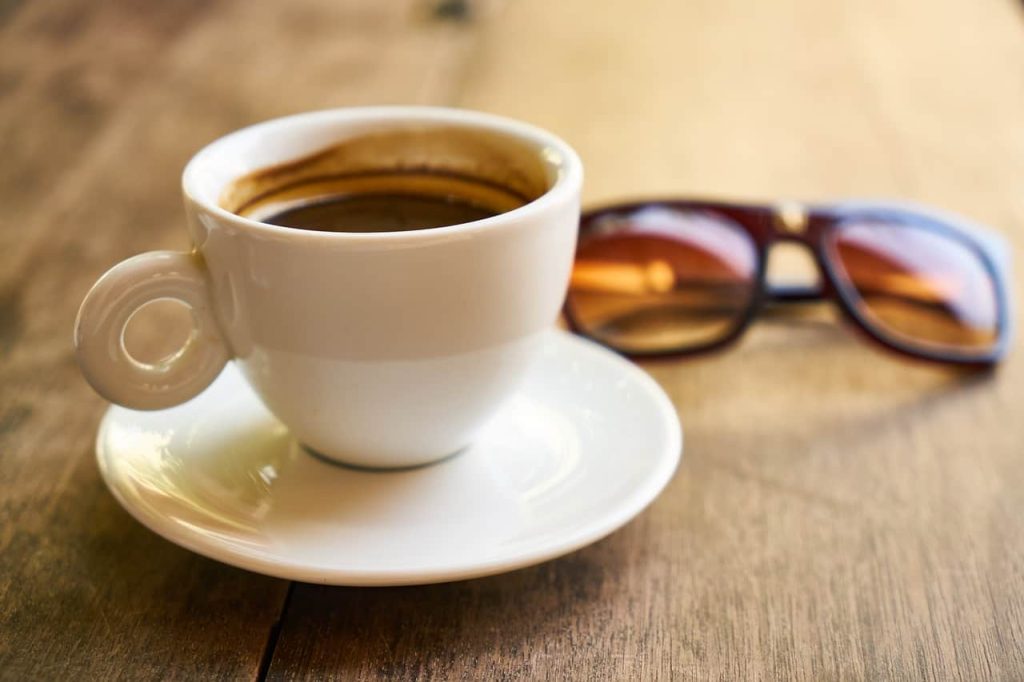
A tasty cup of Joe is the one thing you need to start your day just right. While regular drip coffee may get the job done, there comes a time when you are in the mood for something stronger. It shouldn’t bother you that you don’t have the tools to brew one because today I’ll show you how to make espresso without a machine.
After reading this blog, you should be able to brew espresso from the comfort of your home.
What’s more, with these methods, you can enjoy espresso without having to spend ridiculous amounts of money on coffee bills or espresso machines.
Let’s get started.
What Is Espresso?
Espresso is coffee made by forcing hot water under pressure through finely-ground coffee beans. That’s it. This process is what gives espresso its strength, aroma, and distinct flavor.
For you to master making espresso at home without a machine, you need to understand three things: the beans, the grind process, and the pressure necessary for you to brew espresso coffee.
The Beans
In general, espresso beans are roasted longer than traditional coffee beans. Right off the bat, you will notice they are darker than regular beans, and they have an oily sheen. These qualities are a result of the longer roasting process.
When compared to regular coffee beans that are usually light or medium roasted, espresso beans are more porous thanks to the longer roasting process.
The Grind
Here is the crucial part: the grinding process. Unlike drip coffee, you need to grind your beans to a fine powder if you want to make espresso at home. The more pressure you can generate, the better your espresso will be.
By reducing water penetration, finely ground coffee greatly increases the pressure you need to force hot water through your filters.
Grinding your espresso beans by hand is out of the question. Yes, you can do it, but it will take a lot of time and effort. My advice?
Use any of the best burr coffee grinders, preferably an automatic one. This way, you can get precise and consistent results when grinding your espresso beans.
The Pressure
This is where espresso deviates from drip coffee in preparation. As you know, pressure is needed to force very hot water through fine coffee grounds.
In all honesty, nothing beats espresso made using an espresso machine. This is because the machine can produce tremendous amounts of pressure to make high-grade espresso.
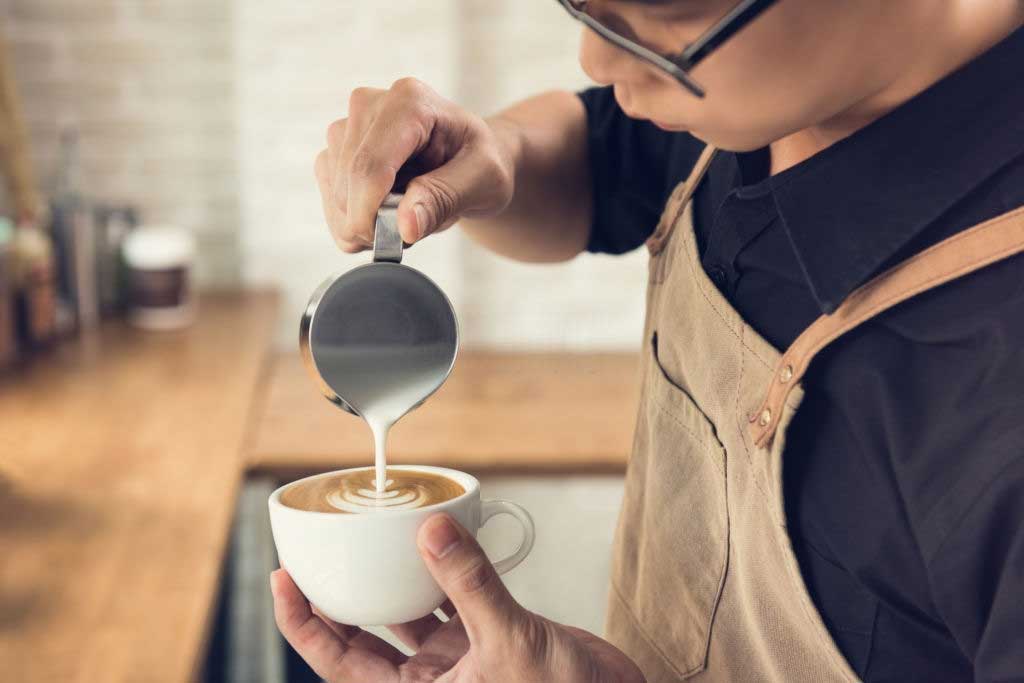
Can you make espresso without a machine? While there is no homemade approach that can compete with a commercial espresso machine, you will have enough pressure to create great espresso using the following methods:
How to Make Espresso without a Machine: 3 Methods
Method 1: With a Moka Pot
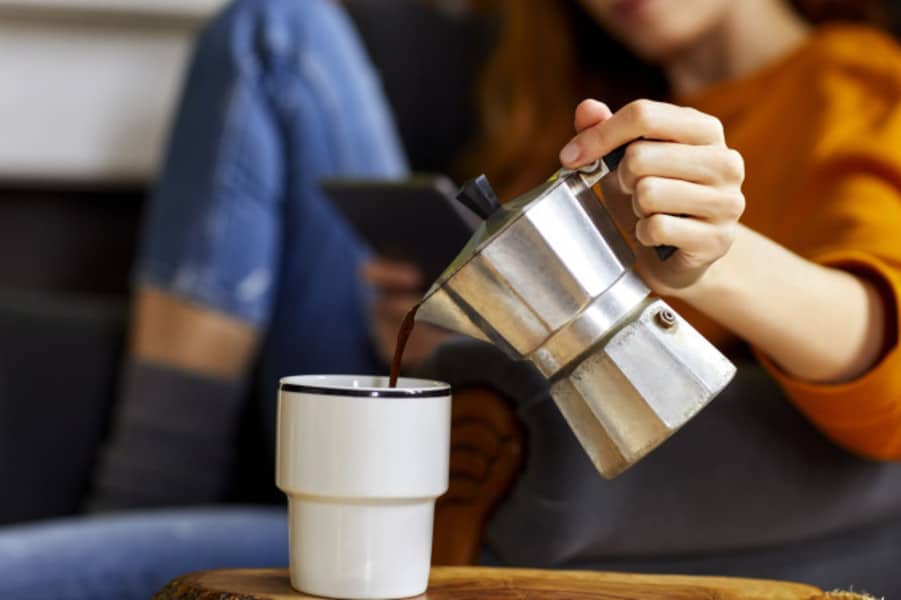
Requirements
- Moka pot
- Stovetop
- Burr grinder
- Espresso beans
- Water
- Electronic scale
While using the moka pot might take some practice to master, it is the best for making your daily shot of espresso without a machine. The pot is an Italian invention that espresso lovers swear by. Basically, it uses steam to create the pressure necessary to prepare espresso.
You will find that using a moka pot is pretty straightforward. It consists of the following parts:
- Lid — Traps the pressure you need to make your espresso
- Upper chamber — Collection for the coffee passing through the funnel
- Funnel — Hot water travels up to the filter through the inner funnel and is forced through the filter into a spout in the upper chamber
- Lower chamber — Container that holds the hot water as it heats up
Instructions
Now to the part you’ve been waiting for: using your moka pot to make espresso. Here’s how you do it.
Step 1: Start by measuring 0.8 ounces of coffee beans on your electronic scale. Use your burr grinder to grind your beans to a fine coffee powder.
Step 2: Next, add water to the lower chamber of your moka pot. Remember, accuracy is important. Make sure your water doesn’t go past the fill line. With too much water, your coffee won’t taste as great as it should.
Step 3: Take your coffee grinds and add them to the filter basket of your pot. You can then attach the top portion of your pot.
Step 4: Next, place your moka pot on the stovetop burner and turn it up to medium heat. As the water in the lower chamber boils, the pressure building up will push the steam through the filter directly into the upper chamber.
Step 5: Once you hear a hissing sound, wait for the coffee to expand and start foaming in the upper chamber. Wait for the upper chamber to fill up with coffee and take your pot from the burner. That’s it! Your espresso is ready to drink.
Keep in mind that brewing espresso using a moka pot takes time to master. The best part is that after a couple of tries, you will be able to make great-tasting espresso from the comfort of your home.
Method 2: With an Aeropress
Requirements
- Aeropress
- Hot water
- Espresso beans
- Electric scale
- Burr grinder for Aeropress
- Thermometer
Instructions
Even if you do not own this versatile coffee-making tool, you still have probably heard of the Aeropress. Did you know that it can be used to make great espresso? Here’s how you go about it:
Step 1: Heat up your water to 185 degrees Fahrenheit. This is the ideal temperature for making espresso on an Aeropress. For the best results, use eight ounces of water, approximately one full cup.
Step 2: Like with the moka pot, grind your coffee beans to a fine powder. Place it on the scale and make sure that it weighs one ounce.
Step 3: Put a fresh filter in the drain cup of your Aeropress. Next, rinse it with hot water and place your drain cap on your Aeropress.
Step 4: Place your Aeropress on your preferred coffee mug. A word of advice: Make sure the cup is strong enough to withstand the pressure you will be putting on it.
Step 5: Add your coffee grounds into the Aeropress. You’ll need to make sure that your coffee is packed tight to increase the pressure build-up. Use an object with a flat surface that can fit in your Aeropress to do this.
Step 6: Measure four fluid ounces of hot water, and pour it into your Aeropress. Swirl the water gently for about five seconds, allowing the water and grounds to mix up.
Step 7: Wait for about 30 seconds, then use the strength of your hand to quickly push down the plunger. You may experience some resistance, but don’t worry. This means your espresso will turn out great.
Step 8: And you’re done! Serve your espresso and enjoy.
The best part about using the Aeropress is that it is easy to clean up. All you have to do is remove the drain cap and press down the plunger while holding it over a trash can. You can then rinse everything using hot water and you are good to go.
Again, what you’ll get from Aeropress is not quite espresso as it doesn’t generate enough pressure. However, you might be pleased to discover that there are actual handy espresso makers that could give you enough pressure bars to create actual espresso.
Method 3: With a French Press
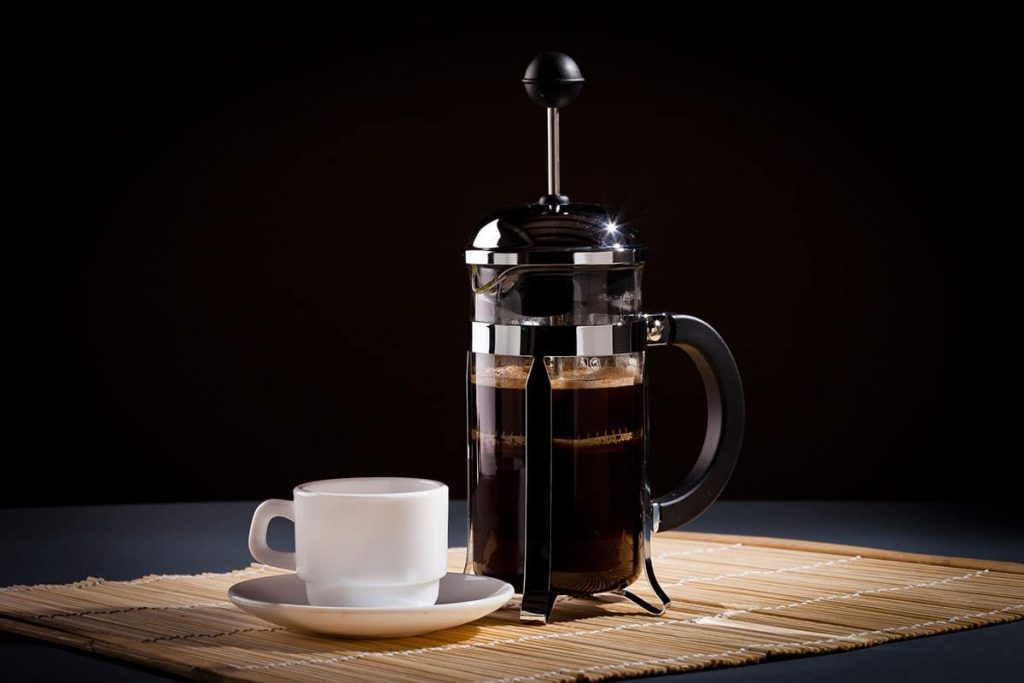
Requirements
- French press
- Burr grinder that can do medium grind
- Espresso beans
- Electric scale
- Thermometer
Instructions
If you are a coffee enthusiast, chances are that you already own a French press. Full disclaimer: While it is great for making strong coffee at home, the French press is not ideal for making espresso.
However, with the right approach, you can produce a great version of espresso with a French Press. Here’s how you go about it:
Step 1: Use your burr grinder to grind your coffee into a fine texture. If you are using an automatic burr grinder, use the fine setting to achieve this.
Step 2: Fill up your kettle and set the water to boil.
Step 3: Add your coffee grounds to your French press. Note that you need roughly twice the amount you use for regular coffee; this will give your homemade espresso the necessary kick and burst of flavors.
Step 4: Measure the temperature of your water using your thermometer. It should be around 200 degrees Fahrenheit.
Step 5: For better espresso, splash hot water on your coffee grounds to trigger the blooming process. The coffee beans will release their oils, increasing flavor. Let your coffee bloom for around 40 seconds.
Step 6: Pour the rest of the water into your French press, then fit and secure the lid. Don’t press the plunger right away, but wait for your brew to settle for about five minutes. This increases the strength of your espresso.
Step 7: Next, slowly press down the plunger, making sure to maintain even pressure. Don’t go all the way down. Get to the halfway point, then pull the plunger all the way to the top. You can then slowly push it all the way to the bottom.
There you have it. Pour your espresso into a cup and enjoy.
The best thing about using the French press to make an espresso-like beverage at home is that you get better with time. Once you lock down and personalize your process, you will be able to produce great-tasting espresso on demand.
These three methods sum up how to make espresso without a machine. What’s clearly common amongst all of them is that they require a bit of time and patience. If that’s not a concern to you, then the journey ahead is most definitely going to be an exciting one.
FAQs on Making Espressos
Can you make espresso without a machine? I’m sure you already know the answer to that by now. So let’s look at a few other frequently asked questions.
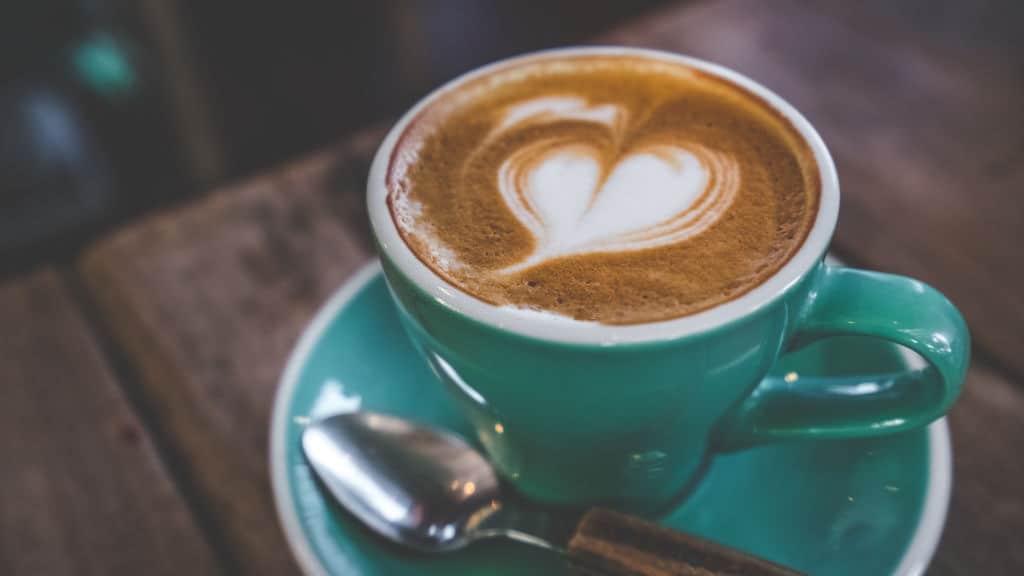
What Is the Difference Between Regular Coffee and Espresso?
Three main differences distinguish espresso from regular coffee: preparation method, bean type, and crema.
- Preparation method: This is the biggest difference between regular coffee and espresso. Preparing regular coffee consists of letting your coarse or medium ground coffee grounds simmer in hot water for a period of time. Please note that this process takes longer.
On the other hand, espresso is made by forcing pressurized hot water through finely-ground coffee beans. - Beans: For the best tasting espresso, you need to use espresso beans. While you can use regular coffee beans to make your espresso, the result might not be that great. Espresso beans are roasted longer than regular coffee beans, giving them a dark and shiny appearance.
- Crema: This is the layer of foam that forms when espresso is made using automatic espresso machines. Regular coffee does not have this foam since it isn’t made using immense pressure.
Can Espresso be Made with a Regular Coffee Maker?
In all honesty, it isn’t possible for you to make espresso coffee using your regular coffee maker. Two things are crucial in the preparation of espresso: speed and pressure.
Of course, your regular drip coffee machine can’t create the pressure necessary for espresso. What’s more, drip coffee machines are designed to brew coffee over longer periods of time.
However, by tweaking your water and coffee measurements, you can brew strong coffee that is close to a shot of espresso. Keep in mind that this will take a couple of trials before you can nail down the process since it is easy to end up with bitter or over-extracted coffee.
What Is the Best Grind for Espresso?
Generally, espresso comes out best when you use finely ground coffee beans. This is because fine grounds need more pressure for hot water to pass through them, and the size affects how your espresso tastes. With more practice, you can learn to tweak the texture of your grind to produce different results.
A word of warning though: If you plan to make espresso without a machine using any of the methods in this blog, make sure not to make your grounds too fine. This might lead to your filter blocking and ruining an otherwise great espresso-making experience.
How Much Espresso Can You Drink?
Now, I know that you love espresso, but you need to be careful about the amount you consume in one sitting. Ever asked yourself why espresso is served in shots? It’s because it’s way stronger than regular coffee.
A shot of espresso (one fluid ounce) contains 62.8 milligrams of caffeine! This means that moderation is key when drinking espresso.
Make no mistake, even your homemade espresso packs quite a punch. Make sure to respect your caffeine limit. It’s the only way you can enjoy your espresso.
Wrap Up
There you have it. I believe all your questions on how to make espresso without a machine have been fully answered. It’s a delicate process, and you’re not going to get a true espresso, but you’ll come close. It’s not as difficult as it may sound. You only need to make sure you are doing your best to master the three things that matter in this process (the beans, the grind, and the pressure). What are you waiting for? Get cracking! Practice makes perfect.
And if in the future you can afford to buy even a lower-end espresso machine to get the real thing, do go for it.
Owen is a writer and editor at Caffe Streets who considers himself a coffee fanatic. He spends his time researching and testing different coffee beans and brewing methods and sharing what he learns with others.






